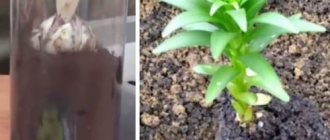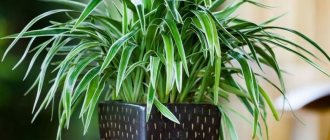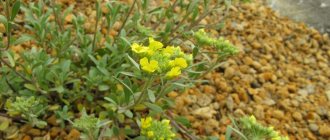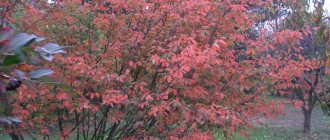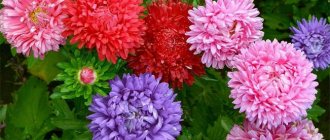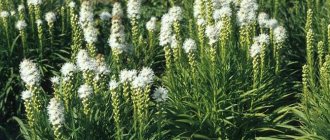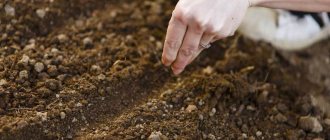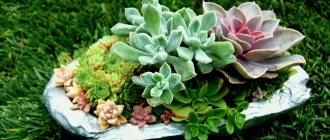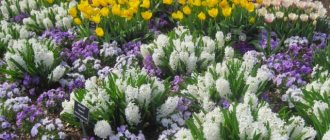Author: Natalya Category: Garden plants Published: February 05, 2019Last edits: January 13, 2021
- Rules of care
- Alpine Aquilegia (Aquilegia alpina)
This biennial is popularly called eagle or columbine; the ancient Germans believed that the flowers of this plant looked like elf slippers, and the British preferred to call aquilegia columbine (dove). This plant is widely in demand in landscape design: low-growing varieties are planted in rock gardens and in winter for forcing, and taller varieties are arranged in groups in ridges and mixborders. But most often aquilegia is used for winter bouquets.
Our article contains information about which types and varieties of aquilegia are the most popular, as well as:
- how to grow aquilegia from seeds;
- what other ways can this plant be propagated;
- how to care for aquilegia.
Planting and caring for aquilegia
- Planting: sowing seeds into the ground immediately after collection or in March for seedlings after stratification of the seed, followed by planting the seedlings in open ground in June.
- Flowering: June-July.
- Lighting: bright sunlight or partial shade.
- Soil: light, loose, moist, rich in humus.
- Watering: infrequent, but regular, in dry hot weather - frequent.
- Fertilizing: 1-2 times per season with complete mineral or organic fertilizer in liquid form.
- Reproduction: seeds, cuttings and dividing the bush.
- Pests: aphids, spider mites, nematodes, cutworm caterpillars.
- Diseases: rust, powdery mildew, gray rot.
Read more about growing aquilegia below.
plant (lat. Aquilegia) , or columbine , or orlik , belongs to the genus of herbaceous perennials of the Ranunculaceae family. According to various sources, there are from 60 to 120 species of plants growing in the mountainous regions of the Northern Hemisphere. About 35 species are grown in culture. There is disagreement about the origin of the Latin name: some claim that it is derived from the words aqua - “water” and legere - “to collect”, while others believe that the name is based on the word aquila, which means “eagle”.
Aquilegia has long been known in the world of flower growers and beyond. It is also mentioned in fiction, for example, in “Hamlet” Ophelia offers her brother Laertes a columbine flower (as the English call aquilegia). And in the paintings of medieval artists, the aquilegia flower symbolized the presence of the Holy Spirit.
- Planting hazel grouse
Aquilegia vulgaris
Has the following characteristics:
- the average height of the bush is 70 centimeters;
- diameter of inflorescences – no more than 5 centimeters;
- The color of the petals is varied, purple and blue shades predominate;
- inflorescences can be double or simple, spurs may be present or absent;
- is the most resistant to low temperatures species.
Botanical description
Aquilegia flowers have a two-year development cycle: in the first year, a regeneration point appears at the base of the shoot, from which by autumn, after flowering, a basal rosette is formed. In spring, the leaves of this rosette die, a second generation of leaves appears, forming a rosette, from the center of which a peduncle will appear, and on it - stem leaves and flowers. The rosette leaves of Aquilegia are on long petioles, twice or thrice trifoliate, and the stem leaves are sessile and trifoliate. Aquilegia flowers are single, drooping, differing depending on the type and variety in size and color: there are blue, yellow, white, crimson, purple, two-color flowers, and also combining several shades.
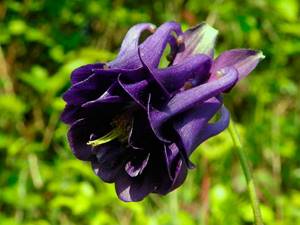
In the photo: Purple Aquilegia
Flowers of many species are equipped with spurs - hollow outgrowths of petals or sepals in which nectar accumulates. The spur species include European and American types of aquilegia - Alpine, ferruginous, Olympic and ordinary, as well as blue, Canadian, Skinner's, golden and Californian aquilegia. Japanese and Chinese species of aquilegia have flowers without spurs. The fruit of Aquilegia is multileaf; small shiny black poisonous seeds remain viable for about a year.
Basic Description
The plant is distinguished by a two-year life cycle - during the first year, a point for renewal is formed, located near the base of its shoot; after the autumn flowering stage, a basal rosette will grow from it. But already in the first days of spring these leaves will die off.
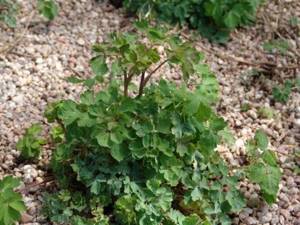
The time comes for the appearance of new leaves, creating a new version of the rosette, and in its center a full-fledged peduncle will be formed, necessary to accommodate the leaves of the stem and flowers.
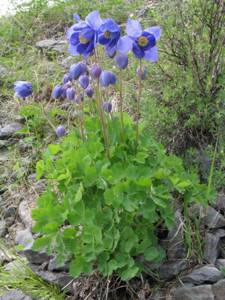
The leaves that create the rosette are distinguished by elongated petioles; they can have two or three sections based on the trifoliate type, while the stems have a sessile structure of the trifoliate type.
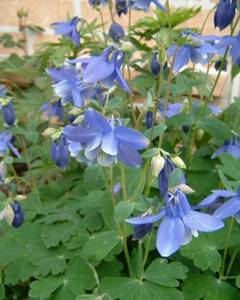
The flowers are distinguished by a single version of the design and they are directed towards the ground, and also differ in different species, varieties: size, color - blue, white, crimson, yellow, two-color based on several shades. You can appreciate their beauty from a photo of aquilegia in all its diversity.
Some species have spurs based on hollow-type processes in the form of cups or full-fledged petals filled with flower nectar.
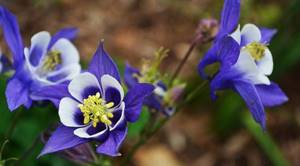
Many species growing in America or Europe have spur characteristics. And various species identified in China or Japan do not have spurs in the flower structure.
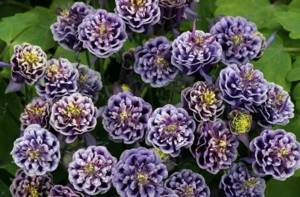
The fruit is formed in a multi-leaf manner on the basis of small shiny and at the same time black seeds, which have poisonous properties and retain the possibility of sprouting throughout the year.
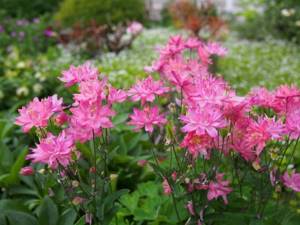
Growing aquilegia from seeds
How to grow aquilegia from seeds? It is best to sow aquilegia in the ground immediately after collecting the seeds, and in the spring, when shoots appear, transplant them to a permanent place. But if you have to postpone sowing until spring, then store the seed at a low temperature.
To prevent aquilegia seeds from losing their viability over the winter, they are mixed with soil and placed in the refrigerator.
In the spring, in March, the seeds are washed from the soil and sown in boxes with a well-compacted and watered light substrate of humus, sand and leaf soil in equal proportions. A 3 mm layer of soil is poured on top of the laid out seeds through a fine sieve and the box is covered with newspaper or burlap. Keep containers with crops in a shaded room at a temperature of 16-18 ºC, moistening the top layer of soil as necessary with a spray bottle. Sprouts usually appear within a week or two from the day of sowing. When the first pair of true leaves appear - usually in late April or early May - the seedlings are transplanted into more nutritious loamy soil.

Aquilegia goldenflower
He is a representative of North American territories. The inflorescences are very large, they stay straight and do not droop down, unlike other varieties. The petals are painted golden. Each inflorescence has long spurs. This species is resistant to low temperatures and drought. Currently, it is quite rare in our regions.
Planting aquilegia
When to plant
Aquilegia sprouts are planted in open ground in June, but not in a permanent place, but for growing. Be sure to shade young plants from the scorching rays of the sun. In a place where they will grow for several years, strengthened and grown young aquilegias are planted in August or spring of next year. The place for planting mature aquilegia can be in partial shade or in the sun. In brightly lit places, their flowering period is somewhat shorter, and the flowers are smaller and weaker than those of those specimens that grow in partial shade. Aquilegia grown from seeds blooms in the second year and reaches full maturity in the third.
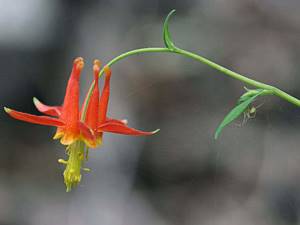
In the photo: Red aquilegia in the garden
How to plant
Aquilegia is an undemanding plant when it comes to soil, but it still grows better in loose, light, moist humus soils. To improve the composition of the soil, dig it up before planting aquilegia with humus or compost at the rate of one bucket of fertilizer per 1 m³. The digging depth is approximately 20 cm. Aquilegia is planted in such a way that there are 10-12 plants per square meter, depending on the variety or species. Tall forms of aquilegia are planted at a distance of 40 cm from each other, low-growing ones - at a distance of 25 cm.
Please note that aquilegia tends to scatter seeds into the soil, so be prepared to fight self-seeding.
But some gardeners allow plants to grow by self-sowing, because after 5-6 years, when the bushes you planted grow old and lose their decorative properties, they can be dug up, leaving young plants that have grown independently in the flowerbed.
Aquilegia alpine
The characteristics of the type are as follows:
- The height of the bush is on average 28 centimeters; if the soil is saturated with nutrients, the height can reach 70 centimeters;
- diameter of inflorescences - up to 8 cm, color blue, light blue, indigo, azure, sky, cornflower blue, dark blue, ultramarine;
- spurs short, curved;
- The flowering period lasts from the end of June to the second ten days of July.
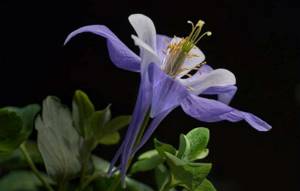
Aquilegia care
Rules of care
As usual, the main care for aquilegia consists of watering, fertilizing, loosening and weeding the soil around the plant during the period of active growth. Aquilegia loves to drink, but since its root system goes deep into the ground, it rarely suffers from a lack of moisture, except in severe drought. Remove weeds on time, especially while the seedlings are young and short; loosen the soil after watering or rain so that moisture does not evaporate quickly from the surface layer of soil and feed the aquilegia so that it finds its best shape. Fertilize areas with aquilegia twice a summer: with mineral fertilizers at the beginning of active growth - 50 g of superphosphate, 15 g of potassium salt and 25 g of nitrate per 1 m² and with a non-concentrated solution of mullein at the rate of 1 bucket per 1 m². Two feedings in the summer are quite enough.
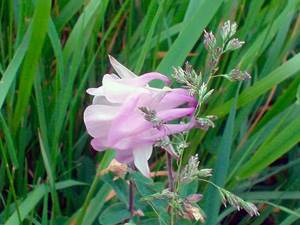
Pictured: Catchment cultivation
Aquilegia propagation
In addition to the seed method for propagating aquilegia, vegetative methods are also used in floriculture - by dividing the bush and cuttings.
Dividing a bush is used only in extreme cases, when it is necessary to preserve some particularly valuable form or variety. The fact is that the root system of aquilegia lies very deep, and fragile roots do not tolerate the procedure of transplantation and division. If you still had to resort to this method, select a bush 3-5 years old in early spring or early autumn, dig it up, very carefully so as not to damage the small roots, wash them off the ground, cut off all shoots at a height of 5-7 cm and all the leaves except two or three of the youngest, then cut the taproot in half lengthwise so that each half contains two or three renewal buds and several small roots, sprinkle the cut with crushed coal and plant the cuttings in boxes with a light but nutritious soil mixture . Most likely, they will be sick for a long time.
How to grow delphinium - practical tips
- Hogweed: parasitic plant - how to fight, photo
Propagation of aquilegia by cuttings is much easier. In the spring, before the leaves have yet blossomed, a young shoot of aquilegia is cut out “with a heel”, the lower end is treated with Kornevin and planted in a greenhouse or in the ground, but under a plastic bottle in loose soil, or better yet, in river sand somewhere shaded from the sun . You will have to water the cuttings without removing the cover, which can only be removed for ventilation in about ten days. Rooting takes about 3-4 weeks, after which the cuttings are dug up and transplanted to a permanent place.
Pests and diseases
Diseases that affect aquilegia include powdery mildew, gray rot and rust. Parts of the plant affected by gray mold must be removed and burned, as well as leaves covered with rust spots. But if gray rot cannot be cured with any preparations, then rust can be combated by spraying with sulfur-containing preparations or a soap solution with copper sulfate.
But most often, aquilegia suffers from powdery mildew - a white fungal coating appears on the leaves and stems, under which the leaves curl, turn brown and die. To get rid of the fungus, you need to spray the plants with a solution of colloidal sulfur with green soap.
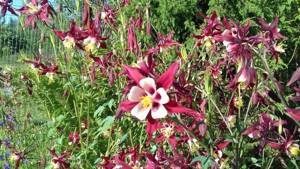
Among insects, the enemies of Aquilegia are aphids, spider mites, cutworms and nematodes. Actellik, yarrow paste and Karbofos have proven themselves well against aphids and spider mites.
But it is very difficult to fight nematodes and often in the end you just have to change the area and plant in the affected flower bed those plants that are not afraid of nematodes - onions, cereals, garlic. Sick plants are burned.
Aquilegia dark
Has the following characteristics:
- the average height of the bush is 75 centimeters;
- the color of the leaf plates is silver or gray;
- the petals are dark purple;
- the diameter of the inflorescences varies within three centimeters;
- each inflorescence has small spurs, they act as stamens;
- the flowering period lasts from late May to mid-June;
- prefers to grow in partial shade.
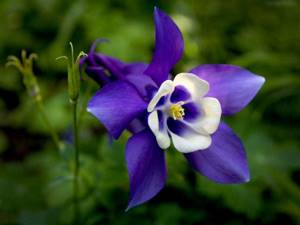
Aquilegia after flowering
When the aquilegia fades, the stems that have lost their decorative effect are cut back to the rosette of leaves. Parts of healthy plants can be used for compost, but diseased plants should be burned to prevent contamination of the soil and other plants. If you want to try the seed propagation method, leave peduncles with flowers of the varieties you need for the seeds to ripen, putting gauze bags on the fruit to avoid self-seeding. After flowering, you can start dividing the bush and at the same time planting plants. At the same time, in September-October, seeds are sown before winter.
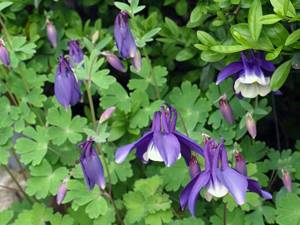
In the photo: Grown from aquilegia seeds
Healing properties of aquilegia
Industrial pharmacology does not use aquilegia as a component for the manufacture of medicines, but in folk medicine this poisonous plant has found wide use. It is indicated for the treatment of:

- hepatitis of various origins;
- stomach colic;
- impotence;
- pneumonia;
- severe cough;
- dropsy;
- painful menstruation;
- mastopathy.
In addition, the water collection has good diuretic and laxative properties. The decoction is used for a number of skin diseases. For this purpose, medicinal baths and compresses are made.
The raw materials are harvested during the flowering period, the stems are cut, not reaching about 10 cm to the ground, and then dried in a well-ventilated area. To prepare the decoction, take a teaspoon of plant material, pour a glass of boiling water and leave for about an hour. Then filter and drink a tablespoon 3 times a day, 15 minutes before meals.
Columbine is a very toxic plant, so it must be used with great caution and only under the supervision of a doctor!
Wintering of Aquilegia
There is one more type of work that needs to be done after the aquilegia blooms. The fact is that in four- to five-year-old plants, the roots begin to protrude from the ground, which affects young leaves and shoots, so after removing the peduncle, you need to pour peat manure compost with humus under the bush to cover these roots. In this way, the aquilegia will receive additional feeding before winter and at the same time will be protected from frost by mulch.
Plant lupine in the garden - a beautiful flower and green manure
Aquilegia fanata
In the photo of aquilegia flowers you can see beautiful lilac-blue petals, along the edges of which there is a white border. The average height of the bush is 55 centimeters. On the basal rosette there are trifoliate leaf plates, the petioles are long. The circumference of the inflorescences is usually no more than 6 centimeters. The spurs on them are oblong, strongly twisted. This species is winter-hardy.
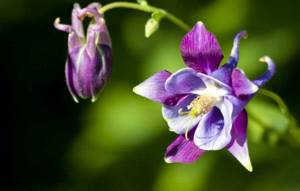
Types and varieties
Despite the fact that aquilegia in nature has about 120 species, not such a large number of them have been introduced into culture. The following species are most often cultivated.
Alpine Aquilegia (Aquilegia alpina)
A low (up to 30 cm) plant that can grow up to 80 cm in height in rich soils. Aquilegia alpine has large flowers - up to 8 cm in diameter, different shades of blue, the spurs are short and curved. This species blooms in late June-early July;
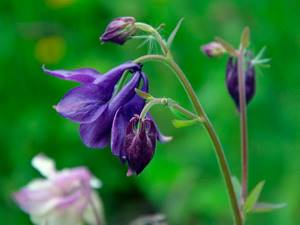
In the photo: Alpine Aquilegia (Aquilegia alpina)
Aquilegia flabellata
Or Aquilegia Akita , a plant up to 60 cm high with trifoliate long-petioled leaves of a basal rosette, with flowers 5-6 cm in diameter with long, strongly curved spurs. There are from one to five flowers on a peduncle; they are blue-lilac in color with a white fuzzy border along the edge. This type of aquilegia is winter-hardy and grows well because it self-sows;
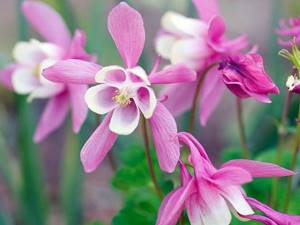
In the photo: Aquilegia flabellata
Common aquilegia (Aquilegia vulgaris)
The European species is 40-80 cm in height with flowers 5 cm in diameter in different shades of blue and purple, but in culture numerous varieties of this type of aquilegia are usually grown with flowers of various colors, simple, double, with spurs or without spurs. This is the most frost-resistant type of aquilegia - can withstand up to -35 ºC;
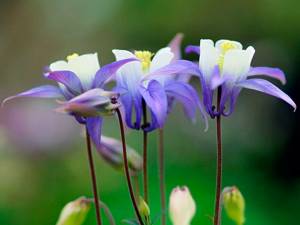
In the photo: Common Aquilegia (Aquilegia vulgaris)
Hybrid Aquilegia (Aquilegia hybrida)
Which combines various forms, most often obtained from crossing American species with Aquilegia vulgaris. Depending on the variety, it grows in height from 50 cm to 1 m. Hybrids have spurs of different lengths; there are also spurless varieties; the flowers are large, up to 9 cm in diameter, both simple and double;
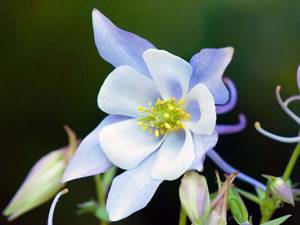
In the photo: Hybrid Aquilegia (Aquilegia hybrida)
Aquilegia chrysantha
A species from North America, characterized by large, non-drooping golden flowers with long spurs. Surprisingly winter-hardy and drought-resistant. It is not yet a frequent visitor to our latitudes, but interest in it among flower growers has recently increased greatly;
- Petunia: pinching, feeding and picking
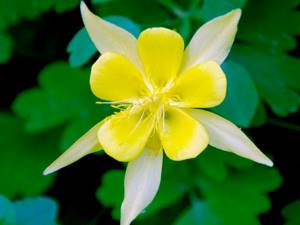
In the photo: Golden-flowered Aquilegia (Aquilegia chrysantha)
Canadian Aquilegia (Aquilegia canadensis)
Also a North American species with straight spurs and red-yellow flowers. Does not like dry places, but grows well in the shade. Also not yet often found in our gardens;
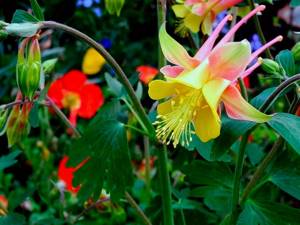
In the photo: Canadian Aquilegia (Aquilegia canadensis)
Dark Aquilegia (Aquilegia atrata)
European species 30-80 cm high with bluish leaves and dark purple drooping flowers 3-4 cm in diameter, short curved spurs and protruding stamens. Blooms in late May-early June. Loves partial shade. It is the base species for breeding varieties with dark flowers. Looks good in flower arrangements and cut flowers;
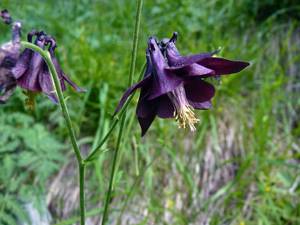
In the photo: Dark Aquilegia (Aquilegia atrata)
Aquilegia olympica
Originally from the Caucasus, Iran and Asia Minor, 30-60 cm in height, densely pubescent stem, large, up to 10 cm in diameter, light blue flowers with long spurs. Blooms from mid-May to mid-June;
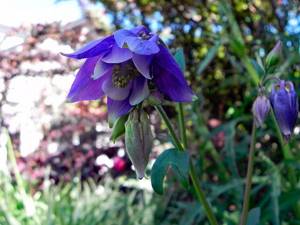
In the photo: Aquilegia olympica
Skinner's Aquilegia (Aquilegia skinneri)
Originally from North America, winter-hardy (down to -12 ºC). The flowers are drooping, red-yellow, the spurs are straight.
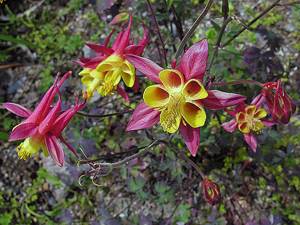
In the photo: Skinner's Aquilegia (Aquilegia skinneri)
In addition to the listed types of aquilegia, which are of interest among flower growers, such species as aquilegia aquilegia aquilegia, parviflora aquilegia, blue aquilegia, bicolor aquilegia, Bertoloni aquilegia, glandular aquilegia, green-flowered aquilegia, Siberian aquilegia, ecalcarata aquilegia and some others are grown in culture.
Contraindications
The following groups of people are strictly prohibited from using traditional medicine recipes:

- pregnant and lactating women;
- children under 14 years of age;
- people who are prone to allergies;
- people who have a number of chronic diseases.
In any case, catchment treatment can only be carried out after weighing all the risks.
Common columbine is a decoration for any flower bed, but do not forget that the plant is extremely poisonous and should not be touched with your hands. If there are small children in the house, then it is better not to plant such flowers on the site in order to avoid trouble.
Columbine (teasum bristles)
Columbine is a herbaceous plant from the genus Teasel, which is widely used in folk medicine.
Initially, teasel grew only in North Africa and Eurasia, then it was introduced and successfully took root in North and South America, Australia, and South Africa. In Russia, the watershed is growing in Crimea, the Caucasus, and the European part of the country.
Teasel bristles is used in folk medicine as a diaphoretic, diuretic, anti-inflammatory and analgesic.
Compound
The chemical composition of the plant has not been studied enough. It has been precisely established that the watershed contains flavonoids, caffeic acid, iridoids, and glycosides.
Beneficial features
The healing properties of the plant are due to the biologically active substances included in its composition. Iridoids have a diaphoretic, diuretic, analgesic and anti-inflammatory effect on the body. Flavonoids have a pronounced anti-inflammatory and wound-healing effect, strengthen the walls of blood vessels and capillaries.
The water collection has a positive effect on the organs of the digestive, cardiovascular, and urinary systems, and has an antitumor effect.
For what diseases is water collection used?
The main indications for the use of teasel are the following pathological conditions of the body:
- mastitis, mastopathy, breast tumors in women;
- urolithiasis and other diseases of the excretory system;
- haemorrhoids;
- peptic ulcer;
- cellulite;
- cysts and polyps of various localizations.
In addition, water collection is one of the most effective means in the treatment of staphylococcal infections, as it has an inhibitory effect on Staphylococcus aureus.
Contraindications
Pregnant and lactating women, as well as children under 12 years of age, are recommended to use water collection only after consultation with their doctor, since the properties of the plant have not been sufficiently studied.
Mode of application
Below are the main recipes for using the catchment in folk medicine:
Decoction No. 1. Take one tablespoon of crushed columbine, pour 0.5 liters of boiling water, leave for 10 minutes in a water bath, cool, filter and take 100-150 milliliters before meals, three times a day. The course of treatment is one month, after which they take a break for 10 days and repeat the course. A total of three monthly courses are required.
Decoction No. 2. Take two tablespoons of crushed teasel, pour 250 milliliters of boiling water, put on fire and boil for another 5 minutes. The prepared decoction is taken an hour before meals, three times a day. Children 6-8 years old are given 30 milliliters per appointment, children 9-14 years old - 50 milliliters, adults - 100 milliliters per appointment. The decoction is taken for 3-4 days, then they take a break for the same period and start drinking the decoction again. The duration of treatment is six months.
Infusion. To prepare it, take one tablespoon of crushed teasel, pour 0.5 liters of boiling water, leave for half an hour, and filter. During the day, the infusion is drunk before meals, three times a day, 100-150 milliliters per dose. At night, make a compress from the infusion, which is applied to sore spots. The course of treatment lasts 20 days, after which they take a break for three days and repeat the treatment. There should be four such courses in total.
